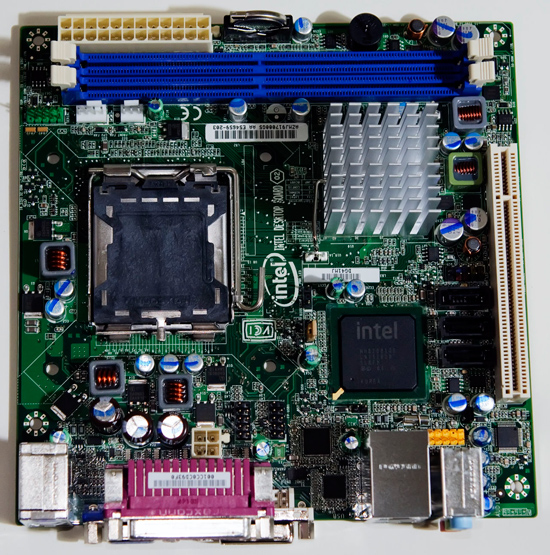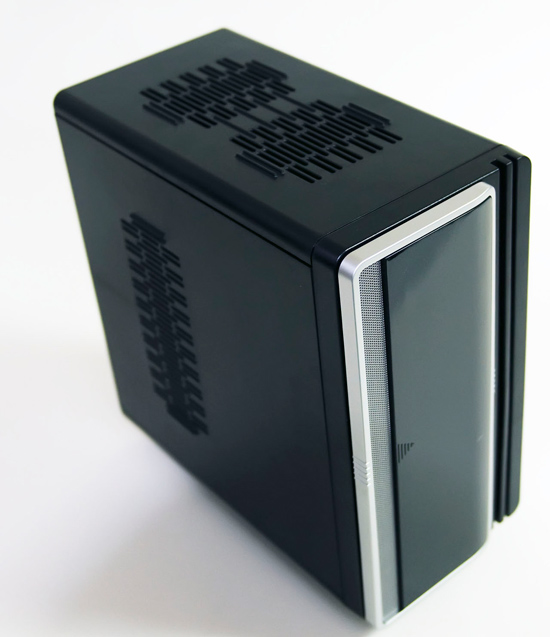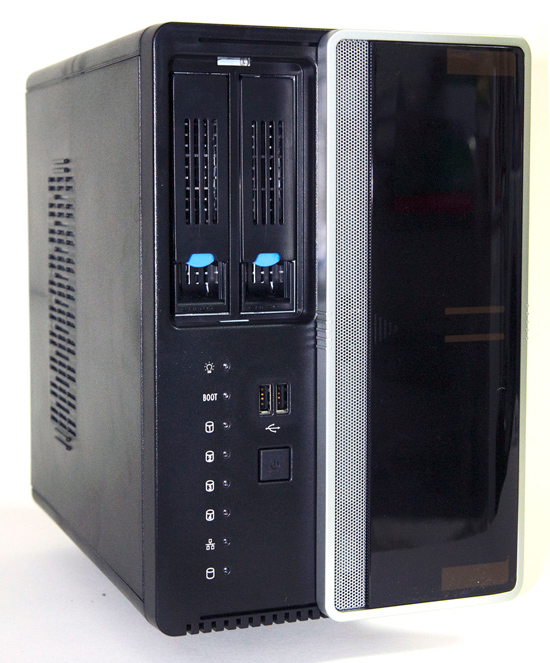Home Servers, Network Storage and the Case House
by Loyd Case on December 2, 2009 12:00 AM EST- Posted in
- Cases/Cooling/PSUs
The X Factor
All we really need around the house is reliable network access, the ReadyNAS would probably run forever – or at least, until it died. But I do like to play with new toys, and I’d been thinking about bringing up a Windows Home Server system for quite a few months.
Of course, you can just buy an off-the-shelf WHS system built by HP or a number of other companies, but that would be too easy. All the PCs in our house were built from the ground up, so I felt compelled to actually build a Windows Home Server system from scratch. Of course, I could have simply taken some of the old PC hardware around here and built up a server from spare parts. That had some attraction, since it would have been fairly inexpensive. It would also have been, in my mind, a somewhat inelegant solution. The smallest power supply I have here is 430W, and even micro ATX cases are bulkier than the ReadyNAS 600.
On the other hand, I’ve had this motherboard for a few months now.

This mini-ITX board is made by Intel, ostensibly for small office or media centric PCs. I never really found a use for it, as most of my applications typically require more graphics horsepower. The Intel DG41MJ board uses the Intel G41 chipset and accepts LGA 775 CPUs (up to 65W TDP.)
Then, one day, I was at my favorite local white box store (Central Computer, in San Jose, CA), and stumbled across this case.

At first, I thought it was just another of many small form factor, slimline cases, ostensibly designed as small Media Center PC cases. But it seemed slightly more bulky than the typical case of that type. The feature list also mentioned “two hot swappable SATA drive bays.” So I slid the front panel open and found that there were, indeed, a pair of hot swappable drive bays.

I checked out the specs and discovered that the Chenbro ES32067 is actually a mini-ITX server case. At roughly $120, it ships with a 150W PSU – smaller than the 220W PSU in the ReadyNAS 600. So I bought one.










87 Comments
View All Comments
webdawg77 - Thursday, December 3, 2009 - link
"so tossed a pair of 1GB Kingston Value RAM modules into the mix" for 2 GB total (table lists 2 GB of RAM twice). Unless, you indeed meant 2 x 2GB sticks (but different from the quote on the third page).Jaguar36 - Thursday, December 3, 2009 - link
I'd love to see some power measurements on this setup. I'm looking for something similar so I don't have to leave my power sucking desktop on all the time.piasabird - Thursday, December 3, 2009 - link
I like the idea of a networked applicance to store files you dont want to lose but many people may not have the funds for this kind of system. Seems like all a lot of people need is an extra PC like a cheap Dell Zion or $495 Dell Intel PC with a Celeron processor and a Drive or two (Depending how many files you actually use). I would find something on that order useful whether it is documents you need to store like Geneological (Family History) documents or Family photos. I cant imagine only having One computer and storing all my photos one one hard drive that could die any minute.I was just thinking of an alternative to this NAS concept. It would be an interesting idea to have a kind of family storage system that could store essential documents on multiple computers instead of having one central location to be used as a server. Then every time a computer would sign on to the network or once a day, each computer could sync up and copy the files back and forth. That way if you had say 2 computers they could share the shared files folders on both computers.
hnzw rui - Thursday, December 10, 2009 - link
You mean something like Dropbox?Devzero - Friday, December 4, 2009 - link
There is actually a lot of software on the marked that accomplishes this task. In my opinion they are dived into two categories.First of you have the sync tools that range from rsync command line like to allway sync GUI appz. These can keep your folders in sync between multiple machines more or less in real time. I've installed openVPN on my laptops so I even get syncing when I'm away from home.
The second tier of tools are more backup like tools like crashplan that you can set upp on multiple machines, and do backup between them. The pro of these kind of appz is that they can keep a backup all changes to a file, so if you should suffer a brain fart and do ctrl + a, del, ctrl + s, alt + f4 in your 2000 pages word document, you can always go back to the previous version.
The best combination of functionality and security in my opinion is to combine the two apps, use allway sync to sync your files between computers, then set up crashplan on one central, always on machine that does online backup.
HotFoot - Thursday, December 3, 2009 - link
If all you're really wanting is back-up on the cheap, but could care less about all the convenience features, then probably the most sensible (but not very sexy) solution is an external HDD that you plug into once every month or two and update. Less than $100 will buy you a great deal of backup space for anything precious or irreplaceable.I do like your concept of taking advantage of multiple computers on the home network to backup important files. That still comes down to added security against a drive failure, and isn't exploiting other potential benefits or features something more sophisticated could offer.
For myself, home servers or even network storage are as yet a solution without a problem. I do a mix of keeping important family photos and documents on a backup external drive and having duplication over a couple computers on my network. But then, I only have one HTPC. I could see wanting a server-based media storage solution if there was more than one entertainment centre where I'd want access to everything. For now, splitting front-end and back-end hasn't yet made sense for me. Of my friends looking at sophisticated home network storage/media server solutions, it almost seems like they are more looking to tinker than actually needing something. It's like their main desktop/gaming rig is as good as it's going to get and they want something new to play with.
mjfink - Thursday, December 3, 2009 - link
I agree with your first statement, external USB HDD (mirrored, if you really need that) are a great way to do backup. I also send my backups across the Internet for an offsite copy.However, I disagree with your 2nd statement. I'd be very upset if my server was removed tomorrow, and there's nothing that would easily replace it. I love not having to leave my main PC on for torrents, and having the reliability of a server to send out all the files/data that I keep on the network.
Most of all it's the networking flexiblity. Full private DNS, DFS for share virtualization (which I use all the time, I want to present a consolidated share with all my shows/movies/etc in it, rather than shares from 3 different computers), an AD domain (which makes life so much easier when accessing data between computers)... It's not that the server solves a problem that didn't exist; it's that most people either don't have these problems (don't have enough computers), or, more likely, don't know that a server would fix these problems for them.
Now, my quad core processor in my desktop rig? That's a solution for a problem that didn't exist. I can't choke that thing doing anything remotely productive; the newest processors are so fast that there's simply no application (besides games) that actually can take advantage of them!
kalster - Thursday, December 3, 2009 - link
For someone on a budget an Atom based system works well too. I built my system using the D945gclf2 (atom 330) and it works well. I haven't used it for any sort of media transcoding but for basic storage and streaming (without transcoding) the atom is a fine chip.Devzero - Thursday, December 3, 2009 - link
My experience with NAS boxes is that they are horrible performers, especial for simple transfers of big files (ie movies). I would love to know how a WHS server like this performs compared to a modern home NAS solution in terms of raw power.blaster5k - Thursday, December 3, 2009 - link
WHS can transfer files pretty much as fast as the hard drives on the machines involved in the transfer can handle. I've moved some big files at close to 100 MB/second. With a RAID/SSD configuration, you might saturate a gigabit connection.